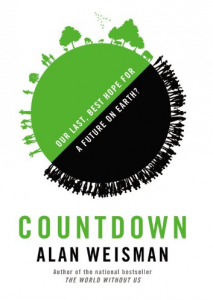Book Review: Alan Weisman’s Countdown: Our Last Best Hope For A Future On Earth

Is overpopulation the source of the world’s problems? Author Alan Weisman thinks so. HNN’s resident book reviewer David Chivers reviews Weisman’s latest book.
In his new book Countdown: Our Last, Best Hope for a Future on Earth? author Alan Weisman persuasively makes the argument that most of the problems facing the world at large stem from a single source: overpopulation. The good news is the world has made great strides towards curbing overpopulation, especially with falling birthrates in the more developed countries and, increasingly, the less developed as well. The bad news is it may already be too late.
Through a deft mixture of reportage and statistics, Weisman shows us in vignette after vignette just how corrosive the effects of too much population are. He is an excellent journalist and writer, and seems to almost effortlessly portray scenes that both illustrate the problems of overpopulation and the problems in fighting it. Basically it comes down to this: even with now lower rates of birth and growth, it still looks like the world will expand to about 10 billion people by 2100, but even our present 7 billion people are making the planet unlivable. The ideal number according to science? About two billion.
Interestingly, probably one of the greatest causes of overpopulation is something that most everybody would consider a good thing—an increase in lifespan brought about by better health. While for the individual longer life is a good thing, these longer lives in the aggregate create a much larger population. And while contraception has brought a great curb in the birthrate, it is just turning the corner now, and the huge birthrate of most of the 20th century, when combined with longer lifespan, has made for nearly exponential increase in our population.
Through enforcement of a China-like one-child per couple law, that number could actually be achieved by the end of the century, but Weisman doesn’t advocate that in a realistic sense. Still, he argues, many measures can be taken, the most simple of which is easier access for the world to contraceptives, which would not only radically cut down on the birth rate in many still struggling nations, but paradoxically also cut down on abortions in those areas, as it is in those areas where abortion is most used as a form of birth control.
Of course, even if we were to magically end the growth rate of population right now, the transition would not be an easy one. Weisman argues and illustrates that for the history of mankind, society has been structured to promote a growth in population. While the birthrate must be lowered, doing so will bring on major societal changes based on the simple fact that there will be this huge bubble of old people being supported by a much smaller base of young people. Think of our Social Security system, which is predicated on a growing number of younger workers taking care of a shrinking number of aged. Now reverse those numbers—a shrinking younger population supporting a growing older generation, and suddenly the numbers don’t work (which we are already starting to see). These societal structures are rampant and must be thought through and addressed, even as we continue to try to shrink the overall population.
If there is one criticism to the book, it’s that example after example seems to illustrate the same basic story. It gets a bit repetitive. Sometimes it’s hard to say whether this cumulative effect is just that, a much needed sense of the global reach of this problem, or whether it is just too much to take in. I finally came down on the former, that these stories are effective in their very accumulation. The fact he can seemingly go anywhere in the world and find sympathetic people to illustrate the problem is just one more sign of how immense the problem is and, more importantly, how we as a society must start to address it.
